标签:
library(‘ggplot2‘)
df <- read.csv(‘G:\\dataguru\\ML_for_Hackers\\ML_for_Hackers-master\\12-Model_Comparison\\data\\df.csv‘)
#用glm
logit.fit <- glm(Label ~ X + Y,family = binomial(link = ‘logit‘),data = df)
logit.predictions <- ifelse(predict(logit.fit) > 0, 1, 0)
mean(with(df, logit.predictions == Label))
#正确率 0.5156,跟猜差不多一样的结果
library(‘e1071‘)
svm.fit <- svm(Label ~ X + Y, data = df)
svm.predictions <- ifelse(predict(svm.fit) > 0, 1, 0)
mean(with(df, svm.predictions == Label))
#改用SVM,正确率72%
library("reshape")
#df中的字段,X,Y,Label,Logit,SVM
df <- cbind(df,data.frame(Logit = ifelse(predict(logit.fit) > 0, 1, 0),SVM = ifelse(predict(svm.fit) > 0, 1, 0)))
#melt的结果,增加字段variable,其中的值有Label,Logit,SVM,增加字段value,根据variable取相应的值
#melt函数:指定变量,将其他剩下的字段作为一个列,把对应的取值列出.melt和cast,好像是相反的功能
predictions <- melt(df, id.vars = c(‘X‘, ‘Y‘))
ggplot(predictions, aes(x = X, y = Y, color = factor(value))) + geom_point() + facet_grid(variable ~ .)
#如下图,Label为真实结果,Lgm完全没用,而SVM有所识别,但边缘不对
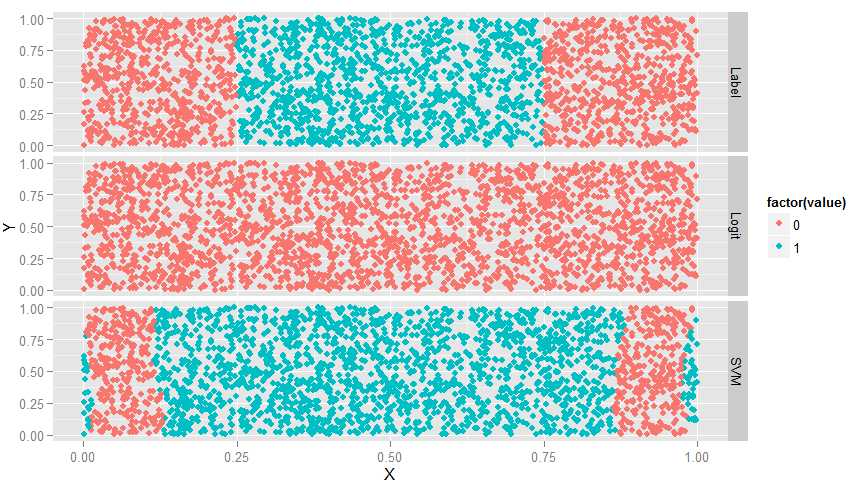
#SVM函数有个kernel参数,取值有4个:linear,polynomial,radial和sigmoid,4个都画出来看看
df <- df[, c(‘X‘, ‘Y‘, ‘Label‘)]
linear.svm.fit <- svm(Label ~ X + Y, data = df, kernel = ‘linear‘)
with(df, mean(Label == ifelse(predict(linear.svm.fit) > 0, 1, 0)))
polynomial.svm.fit <- svm(Label ~ X + Y, data = df, kernel = ‘polynomial‘)
with(df, mean(Label == ifelse(predict(polynomial.svm.fit) > 0, 1, 0)))
radial.svm.fit <- svm(Label ~ X + Y, data = df, kernel = ‘radial‘)
with(df, mean(Label == ifelse(predict(radial.svm.fit) > 0, 1, 0)))
sigmoid.svm.fit <- svm(Label ~ X + Y, data = df, kernel = ‘sigmoid‘)
with(df, mean(Label == ifelse(predict(sigmoid.svm.fit) > 0, 1, 0)))
df <- cbind(df,
data.frame(LinearSVM = ifelse(predict(linear.svm.fit) > 0, 1, 0),
PolynomialSVM = ifelse(predict(polynomial.svm.fit) > 0, 1, 0),
RadialSVM = ifelse(predict(radial.svm.fit) > 0, 1, 0),
SigmoidSVM = ifelse(predict(sigmoid.svm.fit) > 0, 1, 0)))
predictions <- melt(df, id.vars = c(‘X‘, ‘Y‘))
ggplot(predictions, aes(x = X, y = Y, color = factor(value))) + geom_point() + facet_grid(variable ~ .)
#如下图,线性和多项式没用,radial还行,sigmoid很奇怪

#svm有个参数叫degree,看看效果
polynomial.degree3.svm.fit <- svm(Label ~ X + Y, data = df, kernel = ‘polynomial‘, degree = 3)
with(df, mean(Label != ifelse(predict(polynomial.degree3.svm.fit) > 0, 1, 0)))
polynomial.degree5.svm.fit <- svm(Label ~ X + Y,data = df,kernel = ‘polynomial‘,degree = 5)
with(df, mean(Label != ifelse(predict(polynomial.degree5.svm.fit) > 0, 1, 0)))
polynomial.degree10.svm.fit <- svm(Label ~ X + Y,data = df,kernel = ‘polynomial‘,degree = 10)
with(df, mean(Label != ifelse(predict(polynomial.degree10.svm.fit) > 0, 1, 0)))
polynomial.degree12.svm.fit <- svm(Label ~ X + Y, data = df, kernel = ‘polynomial‘, degree = 12)
with(df, mean(Label != ifelse(predict(polynomial.degree12.svm.fit) > 0, 1, 0)))
df <- df[, c(‘X‘, ‘Y‘, ‘Label‘)]
df <- cbind(df,
data.frame(Degree3SVM = ifelse(predict(polynomial.degree3.svm.fit) > 0, 1, 0),
Degree5SVM = ifelse(predict(polynomial.degree5.svm.fit) > 0, 1, 0),
Degree10SVM = ifelse(predict(polynomial.degree10.svm.fit) > 0, 1, 0),
Degree12SVM = ifelse(predict(polynomial.degree12.svm.fit) > 0,1, 0)))
predictions <- melt(df, id.vars = c(‘X‘, ‘Y‘))
ggplot(predictions, aes(x = X, y = Y, color = factor(value))) + geom_point() + facet_grid(variable ~ .)
#从图上看,degreee提升,准确率也提升,此时会有过拟合问题,因此,当使用多项式核函数时,要对degree进行交叉验证
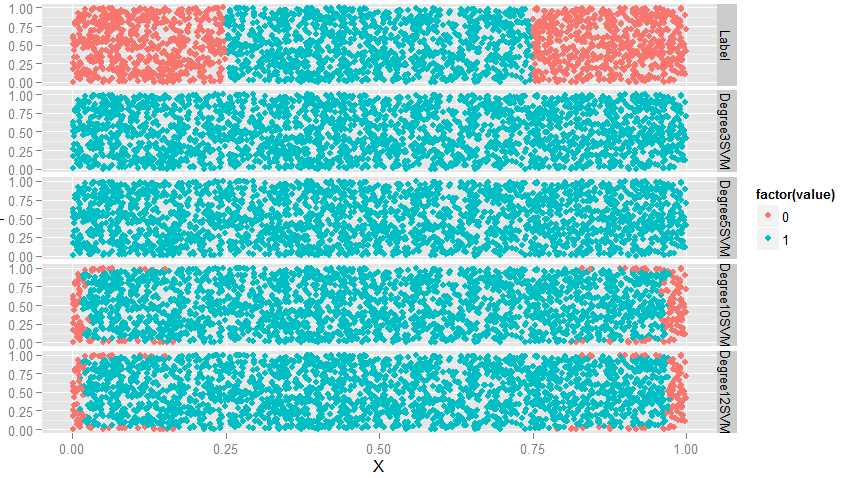
#接下来研究一下SVM的cost参数
radial.cost1.svm.fit <- svm(Label ~ X + Y, data = df, kernel = ‘radial‘, cost = 1)
with(df, mean(Label == ifelse(predict(radial.cost1.svm.fit) > 0, 1, 0)))
radial.cost2.svm.fit <- svm(Label ~ X + Y, data = df, kernel = ‘radial‘, cost = 2)
with(df, mean(Label == ifelse(predict(radial.cost2.svm.fit) > 0, 1, 0)))
radial.cost3.svm.fit <- svm(Label ~ X + Y, data = df, kernel = ‘radial‘, cost = 3)
with(df, mean(Label == ifelse(predict(radial.cost3.svm.fit) > 0, 1, 0)))
radial.cost4.svm.fit <- svm(Label ~ X + Y, data = df, kernel = ‘radial‘, cost = 4)
with(df, mean(Label == ifelse(predict(radial.cost4.svm.fit) > 0, 1, 0)))
df <- df[, c(‘X‘, ‘Y‘, ‘Label‘)]
df <- cbind(df,
data.frame(Cost1SVM = ifelse(predict(radial.cost1.svm.fit) > 0, 1, 0),
Cost2SVM = ifelse(predict(radial.cost2.svm.fit) > 0, 1, 0),
Cost3SVM = ifelse(predict(radial.cost3.svm.fit) > 0, 1, 0),
Cost4SVM = ifelse(predict(radial.cost4.svm.fit) > 0, 1, 0)))
predictions <- melt(df, id.vars = c(‘X‘, ‘Y‘))
ggplot(predictions, aes(x = X, y = Y, color = factor(value))) + geom_point() + facet_grid(variable ~ .)
#如图,cost参数值提升使得效果越来越差,改变非常小,只能通过边缘数据察觉到效果越来越差
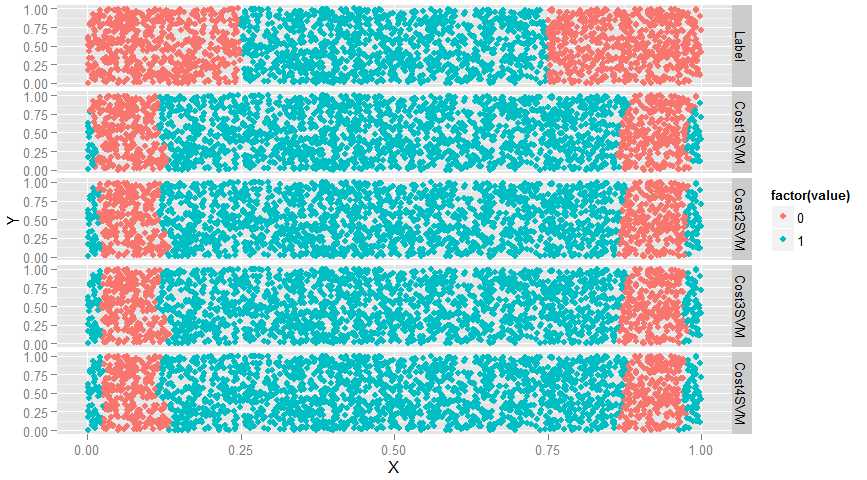
#再来看SVM的参数gamma
sigmoid.gamma1.svm.fit <- svm(Label ~ X + Y, data = df, kernel = ‘sigmoid‘, gamma = 1)
with(df, mean(Label == ifelse(predict(sigmoid.gamma1.svm.fit) > 0, 1, 0)))
sigmoid.gamma2.svm.fit <- svm(Label ~ X + Y, data = df, kernel = ‘sigmoid‘, gamma = 2)
with(df, mean(Label == ifelse(predict(sigmoid.gamma2.svm.fit) > 0, 1, 0)))
sigmoid.gamma3.svm.fit <- svm(Label ~ X + Y, data = df, kernel = ‘sigmoid‘, gamma = 3)
with(df, mean(Label == ifelse(predict(sigmoid.gamma3.svm.fit) > 0, 1, 0)))
sigmoid.gamma4.svm.fit <- svm(Label ~ X + Y, data = df, kernel = ‘sigmoid‘, gamma = 4)
with(df, mean(Label == ifelse(predict(sigmoid.gamma4.svm.fit) > 0, 1, 0)))
df <- df[, c(‘X‘, ‘Y‘, ‘Label‘)]
df <- cbind(df,
data.frame(Gamma1SVM = ifelse(predict(sigmoid.gamma1.svm.fit) > 0, 1, 0),
Gamma2SVM = ifelse(predict(sigmoid.gamma2.svm.fit) > 0, 1, 0),
Gamma3SVM = ifelse(predict(sigmoid.gamma3.svm.fit) > 0, 1, 0),
Gamma4SVM = ifelse(predict(sigmoid.gamma4.svm.fit) > 0, 1, 0)))
predictions <- melt(df, id.vars = c(‘X‘, ‘Y‘))
ggplot(predictions, aes(x = X, y = Y, color = factor(value))) + geom_point() + facet_grid(variable ~ .)
#变弯曲了
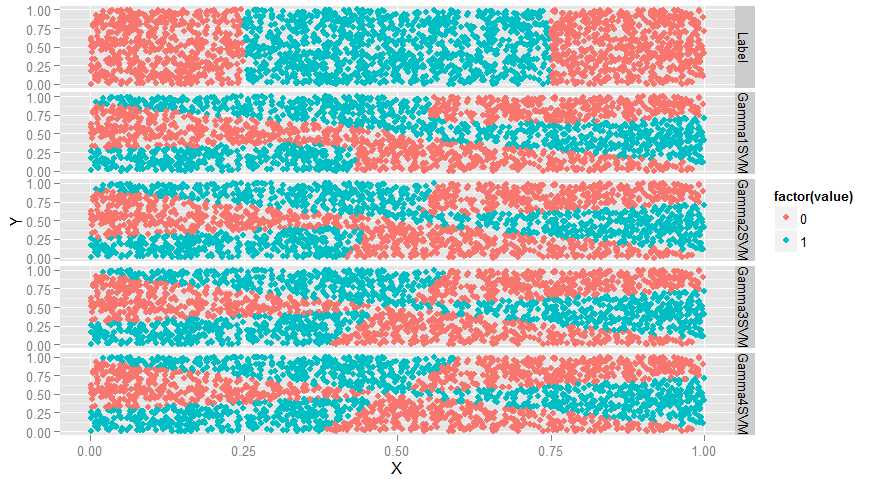
#SVM介绍完毕,意思就是碰到数据集要调参,下面比较一下SVM,glm和KNN的表现
load(‘G:\\dataguru\\ML_for_Hackers\\ML_for_Hackers-master\\12-Model_Comparison\\data\\dtm.RData‘)
set.seed(1)
#一半训练,一半测试
training.indices <- sort(sample(1:nrow(dtm), round(0.5 * nrow(dtm))))
test.indices <- which(! 1:nrow(dtm) %in% training.indices)
train.x <- dtm[training.indices, 3:ncol(dtm)]
train.y <- dtm[training.indices, 1]
test.x <- dtm[test.indices, 3:ncol(dtm)]
test.y <- dtm[test.indices, 1]
rm(dtm)
library(‘glmnet‘)
regularized.logit.fit <- glmnet(train.x, train.y, family = c(‘binomial‘))
lambdas <- regularized.logit.fit$lambda
performance <- data.frame()
for (lambda in lambdas)
{
predictions <- predict(regularized.logit.fit, test.x, s = lambda)
predictions <- as.numeric(predictions > 0)
mse <- mean(predictions != test.y)
performance <- rbind(performance, data.frame(Lambda = lambda, MSE = mse))
}
ggplot(performance, aes(x = Lambda, y = MSE)) + geom_point() + scale_x_log10()
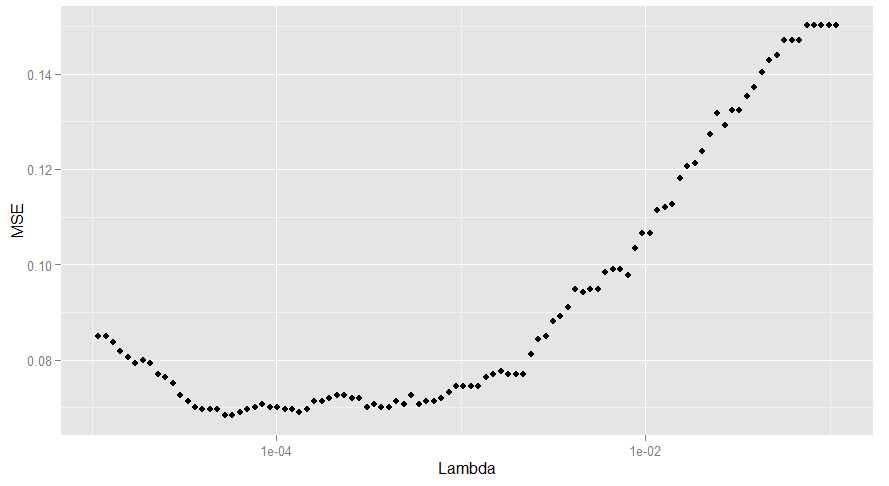
#有两个lambda对应的错误率是最小的,我们选了较大的那个,因为这意味着更强的正则化
best.lambda <- with(performance, max(Lambda[which(MSE == min(MSE))]))
#算一下mse,0.068
mse <- with(subset(performance, Lambda == best.lambda), MSE)
#下面试一下SVM
library(‘e1071‘)
#这一步时间很长,因为数据集大,进行线性核函数时间长
linear.svm.fit <- svm(train.x, train.y, kernel = ‘linear‘)
predictions <- predict(linear.svm.fit, test.x)
predictions <- as.numeric(predictions > 0)
mse <- mean(predictions != test.y)
mse
#0.128,错误率12%,比glm还高.为了达到最优效果,应该尝试不同的cost超参数
radial.svm.fit <- svm(train.x, train.y, kernel = ‘radial‘)
predictions <- predict(radial.svm.fit, test.x)
predictions <- as.numeric(predictions > 0)
mse <- mean(predictions != test.y)
mse
#错误率,0.1421538,比刚才还高,因此知道径向核函数效果不好,那么可能边界是线性的.所以glm效果才会比较好.
#下面试一下KNN,KNN对于非线性效果好
library(‘class‘)
knn.fit <- knn(train.x, test.x, train.y, k = 50)
predictions <- as.numeric(as.character(knn.fit))
mse <- mean(predictions != test.y)
mse
#错误率0.1396923,说明真的有可能是线性模型,下面试一下哪个K效果最好
performance <- data.frame()
for (k in seq(5, 50, by = 5))
{
knn.fit <- knn(train.x, test.x, train.y, k = k)
predictions <- as.numeric(as.character(knn.fit))
mse <- mean(predictions != test.y)
performance <- rbind(performance, data.frame(K = k, MSE = mse))
}
best.k <- with(performance, K[which(MSE == min(MSE))])
best.mse <- with(subset(performance, K == best.k), MSE)
best.mse
#错误率降到0.09169231,KNN效果介于glm和SVM之间
#因此,最优选择是glm
Machine Learning for hackers读书笔记(十二)模型比较
标签:
原文地址:http://www.cnblogs.com/MarsMercury/p/4964885.html